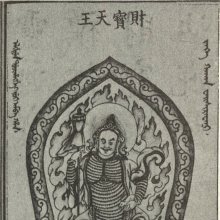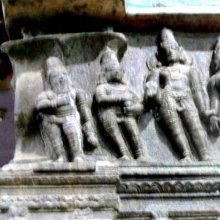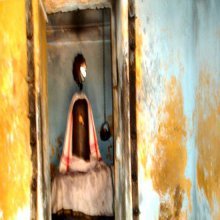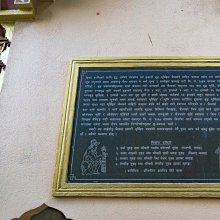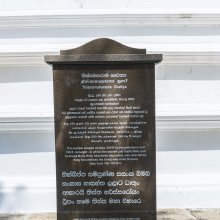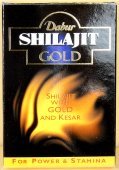Maharaja, Maha-raja, Maha-rajan, Mahārāja, Mahāraja, Maharajan, Mahārājan: 26 definitions
Introduction:
Maharaja means something in Buddhism, Pali, Hinduism, Sanskrit, the history of ancient India, Marathi, Hindi. If you want to know the exact meaning, history, etymology or English translation of this term then check out the descriptions on this page. Add your comment or reference to a book if you want to contribute to this summary article.
Alternative spellings of this word include Maharaj.
Images (photo gallery)
(+1 more images available)
In Hinduism
Purana and Itihasa (epic history)
Source: archive.org: Shiva Purana - English TranslationMahārājan (महाराजन्) refers to a “king”, according to the Śivapurāṇa 2.3.17 (“The dialogue between Indra and Kāmadeva”).—Accordingly, as Kāma said to Brahmā: “Why do you say like this? I make no answer to you. A helping unreal friend is neither seen nor spoken of in the world. He who speaks much at the time of adversity will not turn out much. Yet, O king [i.e., mahārājan], my lord, I shall say something. Please listen. O dear friend, I shall cause the downfall of that enemy of yours who is performing a severe penance to usurp your position. [...]”.
Source: Cologne Digital Sanskrit Dictionaries: The Purana IndexMahārāja (महाराज).—Veda personified as.*
- * Vāyu-purāṇa 104. 85.

The Purana (पुराण, purāṇas) refers to Sanskrit literature preserving ancient India’s vast cultural history, including historical legends, religious ceremonies, various arts and sciences. The eighteen mahapuranas total over 400,000 shlokas (metrical couplets) and date to at least several centuries BCE.
Natyashastra (theatrics and dramaturgy)
Source: Wisdom Library: Nāṭya-śāstraMahārāja (महाराज, “great king”) refers to a specific “mode of address” (nāman) used in drama (nāṭya), according to Nāṭyaśāstra chapter 19.
Mahārāja is used in the following situations:
- Addressing the king,
- By all women addressing their husband if he is the king.

Natyashastra (नाट्यशास्त्र, nāṭyaśāstra) refers to both the ancient Indian tradition (shastra) of performing arts, (natya—theatrics, drama, dance, music), as well as the name of a Sanskrit work dealing with these subjects. It also teaches the rules for composing Dramatic plays (nataka), construction and performance of Theater, and Poetic works (kavya).
Dharmashastra (religious law)
Source: archive.org: The religion and philosophy of the Veda and the Upanishads (dharmashastra)Mahārāja (महाराज) is the name of a deity to be invoked in a certain ritual, according to the Mānavagṛhyasūtra 2.14. Accordingly, the deity is prescribed when one suffers from possession by the Vināyakas, Śālakaṭaṅkaṭa, Kūṣmāṇḍarājaputra, Usmita and Devayajana. The Baijavāpagṛhyasūtra replaces the names of last two vināyakas with Mita and Sammita. According to R. C. Hazra in his Gaṇapati-worship, “this rite is both expiatory and propitiatory in nature and in which various things including meat and fish (both raw and cooked) and wine and cakes are to be offered”..
The gṛhya-sūtras are a branch of dharma-sūtras and refer to a category of Vedic literature dealing with domstic rites and rituals. The Mānava-gṛhya-sūtra belongs to the Kṛṣṇa-yajurveda. The Baijavāpa-gṛhya-sūtra is known only through references to it in other works (e.g., Vīramitrodaya-Saṃskāra).

Dharmashastra (धर्मशास्त्र, dharmaśāstra) contains the instructions (shastra) regarding religious conduct of livelihood (dharma), ceremonies, jurisprudence (study of law) and more. It is categorized as smriti, an important and authoritative selection of books dealing with the Hindu lifestyle.
Ayurveda (science of life)
Rasashastra (Alchemy and Herbo-Mineral preparations)
Source: Wisdom Library: Rasa-śāstraMahārāja (महाराज) or Mahārājarasa is the name of an Ayurvedic recipe defined in the fourth volume of the Rasajalanidhi (chapter 2, dealing with jvara: fever). These remedies are classified as Iatrochemistry and form part of the ancient Indian science known as Rasaśāstra (medical alchemy). Pārvatīśaṅkara is an ayurveda treatment and should be taken with caution and in accordance with rules laid down in the texts.
Accordingly, when using such recipes (e.g., mahārāja-rasa): “the minerals (uparasa), poisons (viṣa), and other drugs (except herbs), referred to as ingredients of medicines, are to be duly purified and incinerated, as the case may be, in accordance with the processes laid out in the texts.” (see introduction to Iatro chemical medicines)

Āyurveda (आयुर्वेद, ayurveda) is a branch of Indian science dealing with medicine, herbalism, taxology, anatomy, surgery, alchemy and related topics. Traditional practice of Āyurveda in ancient India dates back to at least the first millenium BC. Literature is commonly written in Sanskrit using various poetic metres.
Pancaratra (worship of Nārāyaṇa)
Source: University of Vienna: Sudarśana's Worship at the Royal Court According to the AhirbudhnyasaṃhitāMahārāja (महाराज) refers to “glorious sovereigns”, according to the Ahirbudhnyasaṃhitā, belonging to the Pāñcarātra tradition which deals with theology, rituals, iconography, narrative mythology and others.—Accordingly, “[This rite] should be employed by utterly glorious Sovereigns (mahārāja—mahārājair mahābhāgaiḥ) when they are in distress — [for this rite] removes the three kinds of sorrow which begin with the one relating to oneself; causes the destruction of all afflictions; is marked by auspiciousness; destroys all enemies; pacifies (i.e. removes unwanted consequences of ritual mistakes etc.); is the cause of triumph; kills the Demons; brings about prosperities; subdues all; bestows the longest of lives; is meritorious; [and] was perfomed by ancient Kings”.

Pancaratra (पाञ्चरात्र, pāñcarātra) represents a tradition of Hinduism where Narayana is revered and worshipped. Closeley related to Vaishnavism, the Pancaratra literature includes various Agamas and tantras incorporating many Vaishnava philosophies.
In Buddhism
Mahayana (major branch of Buddhism)
Source: Wisdom Library: LokottaravādaMahārāja (महाराज) is the name of a Buddha under whom Śākyamuni (or Gautama, ‘the historical Buddha’) acquired merit along the first through nine bhūmis, according to the Mahāvastu. There are in total ten bhūmis representing the ten stages of the Bodhisattva’s path towards enlightenment.
Mahārāja is but one among the 500 Buddhas enumerated in the Mahāvastu during a conversation between Mahākātyāyana and Mahākāśyapa, both principle disciples of Gautama Buddha. The Mahāvastu is an important text of the Lokottaravāda school of buddhism, dating from the 2nd century BCE.
Source: academia.edu: A Study and Translation of the GaganagañjaparipṛcchāMahārāja (महाराज) refers to the “(four) great kings”, according to the Gaganagañjaparipṛcchā: the eighth chapter of the Mahāsaṃnipāta (a collection of Mahāyāna Buddhist Sūtras).—Accordingly, “Then the bodhisatva Gaganagañja addressed himself to the Lord: ‘O Lord, please give the Tathāgata’s blessing over this exposition of the dharma so that, in the latter time, in the latter age, it will be disseminated and practiced throughout the Jambūdvīpa’. The Lord said: ‘For that reason, son of good family, I will invoke the Four Great Kings (cātur-mahārāja) so that they will come and strive to keep this exposition of the dharma for a long time with detailed and analytical explanation’”.
Source: De Gruyter: A Buddhist Ritual Manual on AgricultureMahārāja (महाराज) refers to a “great king” and is used to describe Vaiśravaṇa, according to the Vajratuṇḍasamayakalparāja, an ancient Buddhist ritual manual on agriculture from the 5th-century (or earlier), containing various instructions for the Sangha to provide agriculture-related services to laypeople including rain-making, weather control and crop protection.—Accordingly, “Then the Bhagavān went to the residence of Vaiśravaṇa, the Great King (mahārāja), with a great retinue, a great assembly-gathering, a great host, an indication of great supernatural power, displaying great miracles”.

Mahayana (महायान, mahāyāna) is a major branch of Buddhism focusing on the path of a Bodhisattva (spiritual aspirants/ enlightened beings). Extant literature is vast and primarely composed in the Sanskrit language. There are many sūtras of which some of the earliest are the various Prajñāpāramitā sūtras.
Tibetan Buddhism (Vajrayana or tantric Buddhism)
Source: Wisdom Library: Tibetan BuddhismMahārājan (महाराजन्) refers to a group of deities summoned by the Yamāntaka-mantra and mentioned as attending the teachings in the 6th century Mañjuśrīmūlakalpa: one of the largest Kriyā Tantras devoted to Mañjuśrī (the Bodhisattva of wisdom) representing an encyclopedia of knowledge primarily concerned with ritualistic elements in Buddhism. The teachings in this text originate from Mañjuśrī and were taught to and by Buddha Śākyamuni in the presence of a large audience (including Mahārājan).

Tibetan Buddhism includes schools such as Nyingma, Kadampa, Kagyu and Gelug. Their primary canon of literature is divided in two broad categories: The Kangyur, which consists of Buddha’s words, and the Tengyur, which includes commentaries from various sources. Esotericism and tantra techniques (vajrayāna) are collected indepently.
India history and geography
Source: Cologne Digital Sanskrit Dictionaries: Indian Epigraphical GlossaryMahārāja.—(IE 8-2; EI 30; CII 3, 4; HD), royal title first assumed by the foreign rulers of India and later adopted by indigenous rulers; originally, an imperial title; later (when the emperors assumed more dignified titles), a title of feudatories and smaller rulers; cf. Greek Basileos Megalou and Old Persian Kshāyathiya vazrka. Cf. Ep. Ind., Vol. IV, p. 211. (IE 8-2), one of the designations sometimes included in the pañca-mahāśabda; cf. the case of Maitraka Dhruvasena I. (IE 8-3), sometimes also called Mahāsāmanta, Mahāpratīhāra, Mahāpīlupati, Pañcādhikaraṇ-oparika, Pāṭy-uparika, Purapāl-oparika, etc., additionally. (IE 8-2), often used in the South even when Mahārājā- dhirāja became the popular imperial title in the North. (ASLV), designation of a priest of the members of the Vallabhācārya sect. Cf. Mahanta-mahārāja, title of pontiffs. Note: mahārāja is defined in the “Indian epigraphical glossary” as it can be found on ancient inscriptions commonly written in Sanskrit, Prakrit or Dravidian languages.

The history of India traces the identification of countries, villages, towns and other regions of India, as well as mythology, zoology, royal dynasties, rulers, tribes, local festivities and traditions and regional languages. Ancient India enjoyed religious freedom and encourages the path of Dharma, a concept common to Buddhism, Hinduism, and Jainism.
Languages of India and abroad
Pali-English dictionary
Source: BuddhaSasana: Concise Pali-English Dictionarymahārāja : (m.) a great king.

Pali is the language of the Tipiṭaka, which is the sacred canon of Theravāda Buddhism and contains much of the Buddha’s speech. Closeley related to Sanskrit, both languages are used interchangeably between religions.
Marathi-English dictionary
Source: DDSA: The Molesworth Marathi and English Dictionarymahārāja (महाराज).—m (S) A sovereign, an emperor, a lord paramount. 2 Applied as a respectful compellation to superiors in general. 3 A deified teacher of the jaina-sect.
Source: DDSA: The Aryabhusan school dictionary, Marathi-Englishmahārāja (महाराज).—m A sovereign; a respectful compellation to superiors.
--- OR ---
mahārāja (महाराज).—n The country of the Marathas.
Marathi is an Indo-European language having over 70 million native speakers people in (predominantly) Maharashtra India. Marathi, like many other Indo-Aryan languages, evolved from early forms of Prakrit, which itself is a subset of Sanskrit, one of the most ancient languages of the world.
Sanskrit dictionary
Source: DDSA: The practical Sanskrit-English dictionaryMahārāja (महाराज).—
1) a great king, sovereign or supreme ruler; पञ्चाशल्लक्षपर्यन्तो महाराजः प्रकीर्तितः (pañcāśallakṣaparyanto mahārājaḥ prakīrtitaḥ) Śukra.1.184.
2) a respectful mode of addressing kings or other great personages (my lord, your majesty, your highness); इति सत्यं महाराज बद्धोऽस्म्यर्थेन कौरवैः (iti satyaṃ mahārāja baddho'smyarthena kauravaiḥ) Mb.
3) a deified Jaina teacher.
4) a fingernail. °अधिराजः (adhirājaḥ) a universal emperor, paramount sovereign. °चूतः (cūtaḥ) a kind of mango tree.
Derivable forms: mahārājaḥ (महाराजः).
Mahārāja is a Sanskrit compound consisting of the terms mahā and rāja (राज).
Source: Cologne Digital Sanskrit Dictionaries: Edgerton Buddhist Hybrid Sanskrit DictionaryMahārāja (महाराज).—(n) , (= Pali id.), (1) one of the four guardians of the cardinal directions, corresponding to Sanskrit lokapāla, and called by this name Dharmasaṃgraha 7, Mūla-Sarvāstivāda-Vinaya i.255.17, and Mahāvyutpatti 3145 as sometimes in Pali, but usually mahārāja(n) in both Pali and [Buddhist Hybrid Sanskrit]: catvāro (°raś ca) mahārājāno or °rājā Lalitavistara 202.13; 366.11; Divyāvadāna 218.9; Avadāna-śataka i.67.10; ii.104.2, 12; instr. Mahāvastu i.230.12; often, as in some of the above, included in lists of other gods; mahārāja-sthānam Saddharmapuṇḍarīka 264.12, the position of world-guardian, as one of five states [Page425-b+ 71] which a woman cannot attain. Pali and [Buddhist Hybrid Sanskrit] differ from Sanskrit in the names assigned to the four individuals, except that Kuvera (Kubera), oftener called Vaiśravaṇa (Pali Vessavaṇa), sometimes Dhanada or other synonyms, is the guardian of the north, as usually in Sanskrit The other three (in Sanskrit normally Indra, Yama, and Varuṇa) are Dhṛtarāṣṭra (east), Virūḍhaka (rarely Virūḍha; south), and Virūpākṣa (west; Pali Dhataraṭṭha, Virūḷha(ka), and Virūpakkha). These four are named, Dharmasaṃgraha 7 (as loka- pāla); Mahāvyutpatti 3146—9 (as prec., lokapālaḥ 3145); Saddharmapuṇḍarīka 4.6—7; Lalitavistara 217.16, 20; 218.4, 9; Suvarṇabhāsottamasūtra 64.2—3; Lalitavistara 382.19 ff. (names 384.6, 10, 11, 15, 16, 20, 21; 385.3); Lalitavistara 388.3, 389.1, 21, 390.19 = Mahāvastu iii.306.9, 307.13, 308.13, 309.13; (Ārya-)Mañjuśrīmūlakalpa 654.21; the four are mentioned as devādhipatayaḥ among the kāmāvacara gods whom Māra perceives as favoring the Bodhisattva, Lalitavistara 302.5—6; and elsewhere in lists of other gods, e.g. Mahāvastu i.245.8—9 where Vaiśravaṇa is separated in the list of gods from the other three; sometimes not all are named, thus only Virūḍhaka, Dhṛtarāṣṭra, Kubera (with other gods) (Ārya-)Mañjuśrīmūlakalpa 434.27—435.1; only Vaiśravaṇa and Virūḍhaka, both styled mahārājo, Saddharmapuṇḍarīka 398.8, 399.5; only Virūḍhaka Mahāvastu iii.72.3 (mahārājo), and 84.1, 6; Indro Virūḍhakādyāś ca (-ādya including the other three?) Laṅkāvatāra-sūtra 367.14; in some of the above the fact is mentioned that Vaiśravaṇa is lord of the yakṣas, Dhṛtarāṣṭra of gandharvas, Virūḍhaka of kumbhāṇḍas, and Virūpākṣa of nāgas; these functions, rather than their position as mahārāja (lokapāla), are exclusively noted in Mahāvyutpatti 3367 (Vaiśr°, first of yakṣas), 3381 (Dhṛt°, of gandharvas), 3437 (Virūḍhaka, of kumbhāṇḍas; no similar statement in Mahāvyutpatti about Virūp°); and, in longer lists of gods, also in Divyāvadāna 126.6—8; 148.18—19; Avadāna-śataka i.108.8—9; Gaṇḍavyūha 249.24—250.2. The forms of the names Dhṛtarāṣṭra and Virūpākṣa never vary; Virūḍha without final -ka (also recorded in Pali) has been noted only Avadāna-śataka i.108.9 and (Ārya-)Mañjuśrīmūlakalpa 654.21 (here verse, perhaps m.c.); Vaiśravaṇa (see also °ramaṇa) is the regular form, for which Kuvera or Kub° is found Dharmasaṃgraha 7; Lalitavistara 218.9; 390.19 = Mahāvastu iii.309.13; (Ārya-)Mañjuśrīmūlakalpa 435.1; Dhanada Divyāvadāna 126.8; 148.19; Avadāna-śataka i.108.9; yakṣarāṭ (Ārya-)Mañjuśrīmūlakalpa 654.21 (verse). In Mūla-Sarvāstivāda-Vinaya i.258.2 ff. Dhṛtarāṣṭra and Virūḍhaka are said to be Aryans (ārya-jātīya), Virūpākṣa and Vaiśravaṇa Dasyus; the Buddha resolves to convert them using āryā vāc and dasyu-vāc respectively; he then preaches to the first two in normal [Buddhist Hybrid Sanskrit], to the others (259.2, 7) using what appear to be meaningless groups of sounds. (2) name of a former Buddha: °jaḥ Mahāvastu i.138.14.
--- OR ---
Mahārājā (महाराजा).—(?) , adj. or subst. f., used (if text is right) with fem. entities: Lalitavistara 391.4 (verse) upasthitā mahārājā (but v.l. mahāvālā) Āśā Śraddhā Hirī Śirī (four of eight deva- kumārikā, the other four named in line 3; compare Mahāvastu iii.309.9, which proves this interpretation); these personages belong to the directions (in this case the north); is mahārājā a fem. equivalent of mahārāja(n), q.v., = Sanskrit lokapāla?
Source: Cologne Digital Sanskrit Dictionaries: Shabda-Sagara Sanskrit-English DictionaryMahārāja (महाराज).—m.
(-jaḥ) 1. A sovereign, an emperor. 2. A finger-nail. 3. A Jaina deified teacher. E. mahā great, rājan a king, aff. ṭac .
Source: Cologne Digital Sanskrit Dictionaries: Benfey Sanskrit-English DictionaryMahārāja (महाराज).—m. 1. a sovereign, king, [Vikramorvaśī, (ed. Bollensen.)] 37, 9. 2. a finger-nail.
Mahārāja is a Sanskrit compound consisting of the terms mahā and rāja (राज).
Source: Cologne Digital Sanskrit Dictionaries: Cappeller Sanskrit-English DictionaryMahārāja (महाराज).—[masculine] great king, sovereign.
Source: Cologne Digital Sanskrit Dictionaries: Monier-Williams Sanskrit-English Dictionary1) Mahārāja (महाराज):—[=mahā-rāja] [from mahā > mah] m. a great king, reigning prince, supreme sovereign, [Brāhmaṇa] etc. etc.
2) [v.s. ...] Name of the moon, [Maitrāyaṇī-saṃhitā]
3) [v.s. ...] of a [particular] deity, [Mānava-gṛhya-sūtra] (-rājan !), [Āpastamba]
4) [v.s. ...] of Kubera, [Taittirīya-āraṇyaka]
5) [v.s. ...] of Viṣṇu, [Bhāgavata-purāṇa]
6) [v.s. ...] [plural] (with Buddhists) a [particular] class of divine beings (the guardians of the earth and heavens against the demons), [Monier-Williams’ Buddhism 206]
7) [v.s. ...] a Jina, [Demetrius Galanos’s Lexiko: sanskritikes, anglikes, hellenikes]
8) [v.s. ...] Name of Mañjuśrī, [cf. Lexicographers, esp. such as amarasiṃha, halāyudha, hemacandra, etc.]
9) [v.s. ...] of the successors of Vallabhācārya (founder of a sect), [Religious Thought and Life in India 135 etc.]
10) [v.s. ...] a finger-nail, [cf. Lexicographers, esp. such as amarasiṃha, halāyudha, hemacandra, etc.]
Source: Cologne Digital Sanskrit Dictionaries: Yates Sanskrit-English DictionaryMahārāja (महाराज):—[mahā-rāja] (jaḥ) 1. m. An emperor; a Jaina teacher.
[Sanskrit to German]
Sanskrit, also spelled संस्कृतम् (saṃskṛtam), is an ancient language of India commonly seen as the grandmother of the Indo-European language family (even English!). Closely allied with Prakrit and Pali, Sanskrit is more exhaustive in both grammar and terms and has the most extensive collection of literature in the world, greatly surpassing its sister-languages Greek and Latin.
Hindi dictionary
Source: DDSA: A practical Hindi-English dictionaryMahārāja (महाराज) [Also spelled maharaj]:—(nm) a king; a term of respect; a cook; ~[rājā] a king, ruler; ~[rājādhirāja] a king of kings, an emperor; ~[rājñī] queen consort; ~[rāṇā] a title held by some rulers of former Indian princely states; ~[rānī] a queen.
...
Kannada-English dictionary
Source: Alar: Kannada-English corpusMaharāja (ಮಹರಾಜ):—
1) [noun] a king.
2) [noun] '''great king'', a mode of addressing a king.'3) [noun] a man whose profession is preparing food; a cook.
--- OR ---
Mahārāja (ಮಹಾರಾಜ):—
1) [noun] a king.
2) [noun] a king of kings.
3) [noun] '''great king'', a mode of addressing a king, saints, etc.'4) [noun] a man whose profession is to prepare food; a cook.
Kannada is a Dravidian language (as opposed to the Indo-European language family) mainly spoken in the southwestern region of India.
Nepali dictionary
Source: unoes: Nepali-English DictionaryMahārāja (महाराज):—n. 1. a great king; sovereign or supreme ruler; 2. a respectful mode of addressing the great saints;
Nepali is the primary language of the Nepalese people counting almost 20 million native speakers. The country of Nepal is situated in the Himalaya mountain range to the north of India.
See also (Relevant definitions)
Partial matches: Maha, Mahanta, Rajan, Raja.
Starts with (+12): Maharaja shyamasah shankara, Maharaja-bappa-svamin, Maharaja-mata, Maharaja-pitamahi, Maharaja-prayojana, Maharaja-saheb, Maharajacuta, Maharajadhi, Maharajadhiraja, Maharajadhiraja-parameshvari, Maharajadhiraja-pati, Maharajadruma, Maharajaghara, Maharajaka, Maharajakayika, Maharajakula, Maharajakulina, Maharajakumara, Maharajalilasana, Maharajamishra.
Query error!
Full-text (+398): Maharajadhiraja, Maharajacuta, Maharajamishra, Maharajadruma, Maharajanighantu, Maharajaphala, Maharajika, Caturmaharaja, Maharajakulina, Maharaja-saheb, Maharaja shyamasah shankara, Maharajarajashri, Kamadeva maharaja, Maharajashri, Uparika-maharaja, Vasudevamaharaja, Maharaja-mata, Maharaja-pitamahi, Brahma-maharaja, Kubera.
Relevant text
Search found 203 books and stories containing Maharaja, Mahā-rāja, Maha-raja, Maha-rajan, Mahā-rājan, Mahanta-raja, Mahanta-raja, Mahanta-rāja, Mahārāja, Mahārājā, Maharāja, Mahāraja, Maharajan, Mahārājan; (plurals include: Maharajas, rājas, rajas, rajans, rājans, Mahārājas, Mahārājās, Maharājas, Mahārajas, Maharajans, Mahārājans). You can also click to the full overview containing English textual excerpts. Below are direct links for the most relevant articles:
The Way of the White Clouds (by Anāgarika Lāma Govinda)
Chapter 23 - Miraculous Escape and Floating Lights < [Part 2 - Pilgrim Life]
Chapter 22 - The Hermit Abbot of Lachen < [Part 2 - Pilgrim Life]
Chapter 21 - Healing Powers < [Part 2 - Pilgrim Life]
The history of Andhra country (1000 AD - 1500 AD) (by Yashoda Devi)
Introduction (Vaidumba dynasty) < [Chapter XVII - The Vaidumbas]
Part 2 - Balliya chola (A.D. 950) < [Chapter XX - The Telugu Cholas (Chodas)]
Introduction (Chola or Choda dynasty) < [Chapter XX - The Telugu Cholas (Chodas)]
The Golden Honeycomb: Fictionalisation < [January – March, 1997]
Indo-Anglian Fiction since Independence < [October 1956]
The Banishment < [January 1971]
Garga Samhita (English) (by Danavir Goswami)
Verse 1.13.30 < [Chapter 13 - The Liberation of Pūtanā]
Verse 8.13.53 < [Chapter 13 - A Thousand Names of Lord Balarāma]
Verse 1.11.20 < [Chapter 11 - Description of Śrī Kṛṣṇacandra’s Birth]
Mudrarakshasa (literary study) (by Antara Chakravarty)
5. About the dramatist (Viśākhadatta) < [Chapter 1 - Introduction]
3. The title of the Play < [Chapter 1 - Introduction]
4. The source of the Mudrārākṣasa < [Chapter 1 - Introduction]
Bhagavati-sutra (Viyaha-pannatti) (by K. C. Lalwani)
Chapter 7: Lokapāla Somadeva < [Book 3]
Chapter 1-4: Lokapālas of Īśānendra < [Book 4]
Chapter 5-8: Capital-cities of Lokapālas < [Book 4]
Related products
